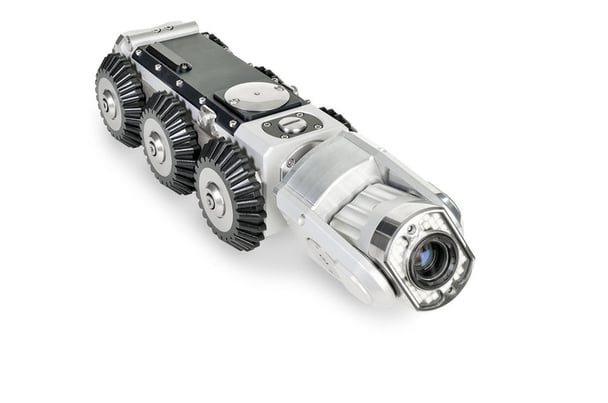When evaluating a sewer inspection crawler for purchase, don’t get distracted by bells and whistles—pay attention to design attributes that keep cost-of-ownership low. These attributes are evident in the core design of the crawler:
 Automatic Cable Management: When a cable reel has closed-loop tension monitoring and adjusts payout/retraction accordingly, it places less strain on the cable connector and motors. The result is fewer cable reterminations and less wear on the drive train.
Automatic Cable Management: When a cable reel has closed-loop tension monitoring and adjusts payout/retraction accordingly, it places less strain on the cable connector and motors. The result is fewer cable reterminations and less wear on the drive train.- Cable Weight: Digital technology means crawler cables need fewer conductors, which makes them lighter for the crawler to pull, and also much easier to reterminate (some can even be field-reterminated). A slender cable also allows a more compact reel, which can install in a smaller vehicle and run off a smaller generator (for added savings).
- Maneuverability: Not only can a steerable, six-wheel drive crawler avoid obstacles and climb offsets, it’s able to remain at the trough of the pipe without requiring the operator to yank on the cable. • Rear-viewing. Most flips and cable tangles happen during reverse crawl, and they can cause major damage to the cable, as well as to the crawler as it’s dragged back to the manhole. A rear-view camera positioned above the cable (combined with automatic cable management) is the best prevention.
- Self-Diagnostics: The miniaturization of digital sensors now allows crawlers to monitor their own pressure, temperature, humidity, electrical current, pitch and roll. All this information can be logged for troubleshooting purposes, and to prompt real-time operator warnings. • Digital Platform. CANbus and similar digital control architectures not only enable longevity-enhancing features (like soft-starting motors, rollover alerts, and clutch lockout on inclines), they help prevent obsolescence by allowing crawlers to auto-update their own firmware features, and enabling them to accept any number of accessories on a plug-and-play basis.
- Quick-Change Design: When wheels and accessories attach with multiple threaded connectors, it not only makes reconfiguration cumbersome, it discourages proper cleaning. Tool-free wheels detach in seconds, promoting regular cleaning where seals experience the most wear, and where debris tends most to accumulate. Eliminating threaded fasteners also eliminates the risk of cross-threading damage, which can happen easily over hundreds of threading cycles.
- Materials: Proper sealing requires maximum rigidity, so the crawler should be constructed out of monolithic blocks of non-ductile metal. Likewise, cable should incorporate Kevlar or similar fortification for maximum break strength.
- General Craftsmanship: Exposed wires, lots of sealed joints, recesses where debris can accumulate, and extraneous moving parts—these all signal the potential for service issues.
Features are important—a crawler has to be suited to your specific challenges and support your work flow. However, core design attributes have a much greater bearing on durability and dependability, which are key determinants for cost-of-ownership.
This blog post is an excerpt from the white paper "7 Secrets to Low Cost-of-Ownership For Sewer Crawlers". Click below to read more.

